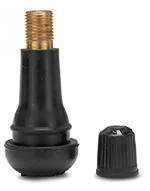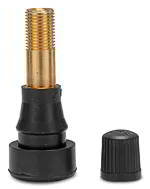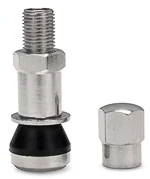Tire Valves
Buy quality original equipment and replacement tire valves and components at best prices online.
There are three common types of tire valves: rubber snap-in tire valve, high-pressure snap-in tire valve and high-pressure metal clamp-in tire valve. Use of appropriate tire valve is based on wheel design, tire inflation pressures required, vehicle specifications and driving conditions.
Tubeless rubber snap-in tire valves are designed for passenger cars and some light trucks with maximum allowed cold tire inflation pressure of 65 psi. Rubber snap-in valves can fit either .453" or .625" diameter holes in the rim, with effective length range of .88" to 2.5". Tubeless rubber snap-in valves mostly use plastic tire valve caps.

Tubeless high-pressure snap-in tire valves are designed for medium and heavy-duty trucks and trailers when recommended cold tire inflation pressures exceed 65 psi. High-pressure snap-in valves allow a maximum cold inflation pressure of 80 psi for .453" rim holes, and maximum cold inflation pressure of 100 psi for .625" rim holes, with effective length range of 1.27" to 2". High-pressure snap-in tire valves are mostly used in steel wheels, featuring thicker rubber snap-in base with a metal barrel, and using plastic caps.

High-pressure metal clamp-in tire valves can be used with almost all wheels. They are available in straight or bent configurations to fit wheels with unique shapes. They are also highly recommended for high speed applications. Metal clamp-in valves can fit either .453" or .625" rim holes, as well as 6mm (.236") or 8mm (.315") holes, while allowing a maximum operating pressure of 200 psi, with effective lengths ranging from flush to 2". Metal clamp-in tire valves use metal caps.

Tire valves can be aligned in any position to complement wheel styling. To fit valve mounted tire pressure monitoring system sensors and to avoid air pressure loss at high speeds, mostly horizontal valve alignment is used by wheel manufacturers.
Tire valve consists of a valve core that is screwed into the valve stem. Valve cores come in short and long lengths, and can be nickel-plated and brass. Short valve cores are preferred for high performance applications. Only nickel-plated valve cores must be used in the aluminum valve stems of tire pressure monitoring sensors. Inside the valve core is a seal attached to spring-loaded pin that allows movement of pressurized air in when inflating a tire, and out when releasing air from a tire. Keep the valve core clean and protect it from dirt and moisture to maintain its proper functionality.
Tire valve caps are used to prevent valve core contamination keeping away any dirt and moisture, and to avoid high speed air pressure loss providing a backup seal that prevents air from escaping in case the valve core's seal fails. Valve caps can be plastic or metal, with metal tire valve caps often used for high speed driving to withstand the high temperatures.
Tire valves deteriorate over time and it is recommended to replace them when installing new tires.
